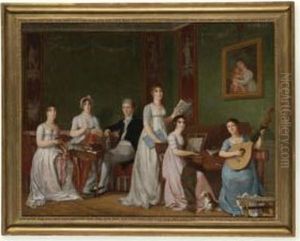Per (the elder) Krafft Paintings
Per Krafft the Elder was a Swedish portrait painter born on January 16, 1724, in Arboga, Sweden. He was one of the most prominent Swedish artists of the 18th century, known especially for his portrait work. Krafft's artistic talent was evident from a young age, and he received his initial training from his father, who was also a painter.
Krafft's career began to flourish after he moved to Stockholm, where he became a student at the Royal Swedish Academy of Arts. He further honed his skills and knowledge of the arts during a period of study abroad, which was a common practice among European artists of the time. He spent a significant amount of time in France, where he was influenced by the French Rococo style, characterized by its elegance, color, and lightness.
In 1758, after returning to Sweden, Per Krafft the Elder was appointed court painter to King Adolf Frederick of Sweden. This position provided him with a stable income and allowed him to become a central figure in the Swedish art scene. He painted numerous portraits of the Swedish royal family, nobility, and prominent figures of his time, capturing the cultural and societal atmosphere of the Swedish court.
Krafft's portraits are known for their meticulous detail and the ability to convey the personality and social status of his subjects. He had a keen eye for capturing the textures of fabrics and the subtleties of facial expressions. His work is an important source for understanding Swedish fashion and interior design of the 18th century.
Outside of his portrait work, Krafft was also invested in the development of the Royal Swedish Academy of Arts, where he served as a professor from 1773 until his death on October 1, 1793, in Stockholm. His contributions to the Academy helped shape the education of many young Swedish artists who would follow in his footsteps.
Today, Per Krafft the Elder's paintings can be found in various museums and collections, including the Nationalmuseum in Stockholm, which houses the largest collection of his work. His legacy is seen in the influence he had on Swedish portraiture and the role he played in the cultural life of 18th-century Sweden.
















